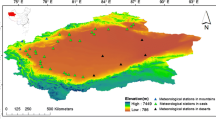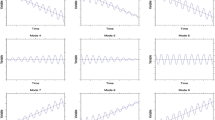Abstract
Air temperature (AT) is a subsystem of a complex climate. Long-range correlation (LRC) is an important feature of complexity. Our research attempt to evaluate AT’s complexity differences in different land-use types in the Heihe River Basin (HRB) based on the stability and LRC. The results show the following: (1) AT’s stability presents differences in different land-use types. In agricultural land, there is no obvious variation in the trend throughout the year. Whereas in a desert, the variation in the trend is obvious: the AT is more stable in summer than it is in winter, with Ta ranges of [8, 20]°C and SD of the AT residual ranges of [0.2, 0.7], respectively. Additionally, in mountainous areas, when the altitude is beyond a certain value, AT’s stability changes. (2) AT’s LRC presents differences in different land-use types. In agricultural land, the long-range correlation of AT is the most persistent throughout the year, showing the smallest difference between summer and winter, with the Hs range of [0.8, 1]. Vegetation could be an important factor. In a desert, the long-range correlation of AT is less persistent, showing the greatest difference between summer and winter, with the Hs range of [0.54, 0.96]. Solar insolation could be a dominant factor. In an alpine meadow, the long-range correlation of AT is the least persistent throughout the year, presenting a smaller difference between summer and winter, with the Hs range of [0.6, 0.85]. Altitude could be an important factor. (3) Usually, LRC is a combination of the Ta and SD of the AT residuals. A larger Ta and smaller SD of the AT residual would be conducive to a more persistent LRC, whereas a smaller Ta and larger SD of the AT residual would limit the persistence of LRC. A larger Ta and SD of the AT residual would create persistence to a degree between those of the first two cases, as would a smaller Ta and SD of the AT residual. In addition, the last two cases might show the same LRC.
Similar content being viewed by others
References
Armbruster W S, 2007. Topographic Complexity and Terrestrial Biotic Response to High-latitude Climate Change: Variance is as Important as the Mean. Berlin Heidelberg: Springer. doi: https://doi.org/10.1007/978-3-540-48514-8_7.
Cheng K, Su Y, Kuo F et al., 2008. Assessing the effect of landcover changes on air temperature using remote sensing images: A pilot study in northern Taiwan. Landscape and Urban Planning, 85(2): 85–96.
Christian F. 2012. Nonlinear trends, long-range dependence, and climate noise properties of surface temperature. Journal of Climate, 25(12): 4172–4183.
Cohen S D, Tarara J M, Gambetta G A et al., 2012. Impact of diurnal temperature variation on grape berry development, proanthocyanidin accumulation, and the expression of flavonoid pathway genes. Journal of Experimental Botany, 63(7): 2655–2665.
David R, 1999. Complexity and climate. Science, 284(5411): 105–107.
Gao J, Cao Y, Tung W et al., 2007. Multiscale Analysis of Complex Time Series: Integration of Chaos and Random Fractal Theory, and Beyond. New Jersey: John Wiley & Sons. doi: https://doi.org/10.1002/9780470191651.
Gao J, Hu J, Tung W, 2011. Facilitating joint chaos and fractal analysis of biosignals through nonlinear adaptive filtering. PLoS One, 6(9): 1–8.
Gao J B, Fang P, Yuan L H, 2019. Analyses of geographical observations in the Heihe River Basin: Perspectives from complexity theory. Journal of Geographical Sciences, 29(9): 1441–1461.
Gian-Reto W, Eric P, Peter C et al., 2002. Ecological responses to recent climate change. Nature, 416(6879): 389–395.
Guo W, Qiao X, Huang Y et al., 2012. Study on energy saving effect of heat-reflective insulation coating on envelopes in the hot summer and cold winter zone. Energy and Buildings, 196–203.
Irvine D J, Briggs M A, Lautz L K et al., 2017. Using diurnal temperature signals to infer vertical groundwater-surface water exchange. Groundwater, 55(1): 10–26.
Isaac H. 2014. Simplicity amid complexity. Science, 343(6176): 1206–1207.
Jon B Ø, Roland K, Ingunn T et al., 2007. Arctic alpine ecosystems and people in a changing environment. Berlin: Springer Science & Business Media. doi: https://doi.org/10.1007/978-3-540-48514-8.
Kang J, Jin R, Li X et al., 2015. HIWATER: WATERNET observation dataset in the upper reaches of the Heihe River Basin in 2014. Heihe Plan Science Data Center. doi: https://doi.org/10.3972/hiwater.219.2014.db.
Katharine L, Ricke M, Granger M et al., 2010. Regional climate response to solar-radiation management. Nature Geoscience, 3(8): 537–541.
Körner C, 2007. The use of ‘altitude’ in ecological research. Trends in Ecology & Evolution, 22(11): 569–574.
Lene Ø, Tine N, Kristoffer R et al., 2014. Long-range memory in internal and forced dynamics of millenniumlong climate model simulations. Earth System Dynamics, 5(2): 295.
Liu S M, Xu Z W, Wang W Z et al., 2011. A comparison of eddy-covariance and large aperture scintillometer measurements with respect to the energy balance closure problem. Hydrology and Earth System Sciences, 15(4): 1291–1306. doi: https://doi.org/10.5194/hess-15-1291-2011.
Luis A, Gil A, 2012. Long memory, seasonality and time trends in the average monthly temperatures in Alaska. Theoretical and Applied Climatology, 108(3/4): 385–396.
Mathew A, Khandelwal S, Kaul N, 2018. Analysis of diurnal surface temperature variations for the assessment of surface urban heat island effect over Indian cities. Energy and Buildings, 159: 271–295.
Michael A, Riley, Scott B et al., 2012. A tutorial introduction to adaptive fractal analysis. Frontiers in Physiology, 3: 1–10.
Orlandini S, Marta A, Mancini M, 2006. The agroclimatic analysis at farm scale. Meteorological Applications, 13(Suppl.1): 87–93.
Running S W, Nemani R R, Hungerford R D, 1987. Extrapolation of synoptic meteorological data in mountainous terrain and its use for simulating forest evapotranspiration and photosynthesis. Canadian Journal of Forest Research, 17: 472–483.
Shao J, Li Y, Ni J, 2012. The characteristics of temperature variability with terrain, latitude and longitude in Sichuan-Chongqing Region. Journal of Geographical Sciences, 22(2): 223–244.
Shen S, Ye S J, Cheng C X et al., 2018. Persistence and corresponding time scales of soil moisture dynamics during summer in the Babao River Basin, Northwest China. Journal of Geophysical Research: Atmospheres, 123: 8936–8948.
Sheri A S, Liyin L L, Steven M C et al., 2017. Variation in the urban vegetation, surface temperature, air temperature nexus. Science of the Total Environment, 579: 495–505.
Solomon Z, Dobrowski J T, Abatzoglou J A et al., 2009. How much influence does landscape-scale physiography have on air temperature in a mountain environment? Agricultural and Forest Meteorology, 149(10): 1751–1758.
Song C Q, Yuan L H, Yang X F et al., 2017. Ecological-hydrological processes in arid environment: Past, present and future. Journal of Geographical Sciences, 27(12): 1577–1594.
Wang K, Sun J, Cheng G D et al., 2011. Effect of altitude and latitude on surface air temperature across the Qinghai-Tibet Plateau. Journal of Mountain Science, 8(6): 808–816.
Wu D, Zhao X, Liang S et al., 2015. Time-lag effects of global vegetation responses to climate change. Global Change Biology, 21(9): 3520.
Wu W, Tian J, Zhao C et al., 2013. Multi-scale analysis of the long-term trend of the hydrometeorological variables in the upper reach of the Heihe River, Northwest China. Marine Geology & Quaternary Geology, 33(4): 37–44.
Xu J, Chen Y, Li W et al., 2013. Understanding the complexity of temperature dynamics in Xinjiang, China, from multitemporal scale and spatial perspectives. The Scientific World Journal, doi. https://doi.org/10.1155/2013/259248.
Yang P, Xiao Z, Liu W, 2013. Comparison of diurnal temperature variation in urban and rural areas in Beijing and its seasonal change. Chinese Journal of Atmospheric Sciences, 37(1): 101–112. (in Chinese)
Zhang J, Kang E, Lan Y et al., 2003. Impact of climate change and variability on water resources in Heihe River Basin. Journal of Geographical Sciences, 13(3): 286–292.
Zhang T, Shen S, Cheng C X et al., 2018. Long-range correlation analysis of soil temperature and moisture on A’rou hillsides, Babao River Basin. Journal of Geophysical Research: Atmospheres, 123: 12606–12620.
Acknowledgments
We would like to thank the high-performance computing support from the Center for Geodata and Analysis, Faculty of Geographical Science, Beijing Normal University [https://gda.bnu.edu.cn/].
Author information
Authors and Affiliations
Corresponding author
Additional information
Foundation
Strategic Priority Research Program of the Chinese Academy of Sciences, No.XDA23100303
Author:
Yang Jing (1989-), specialized in spatial-temporal analysis and disaster research.
Rights and permissions
About this article
Cite this article
Yang, J., Su, K. & Ye, S. Stability and long-range correlation of air temperature in the Heihe River Basin. J. Geogr. Sci. 29, 1462–1474 (2019). https://doi.org/10.1007/s11442-019-1671-5
Received:
Accepted:
Published:
Issue Date:
DOI: https://doi.org/10.1007/s11442-019-1671-5




